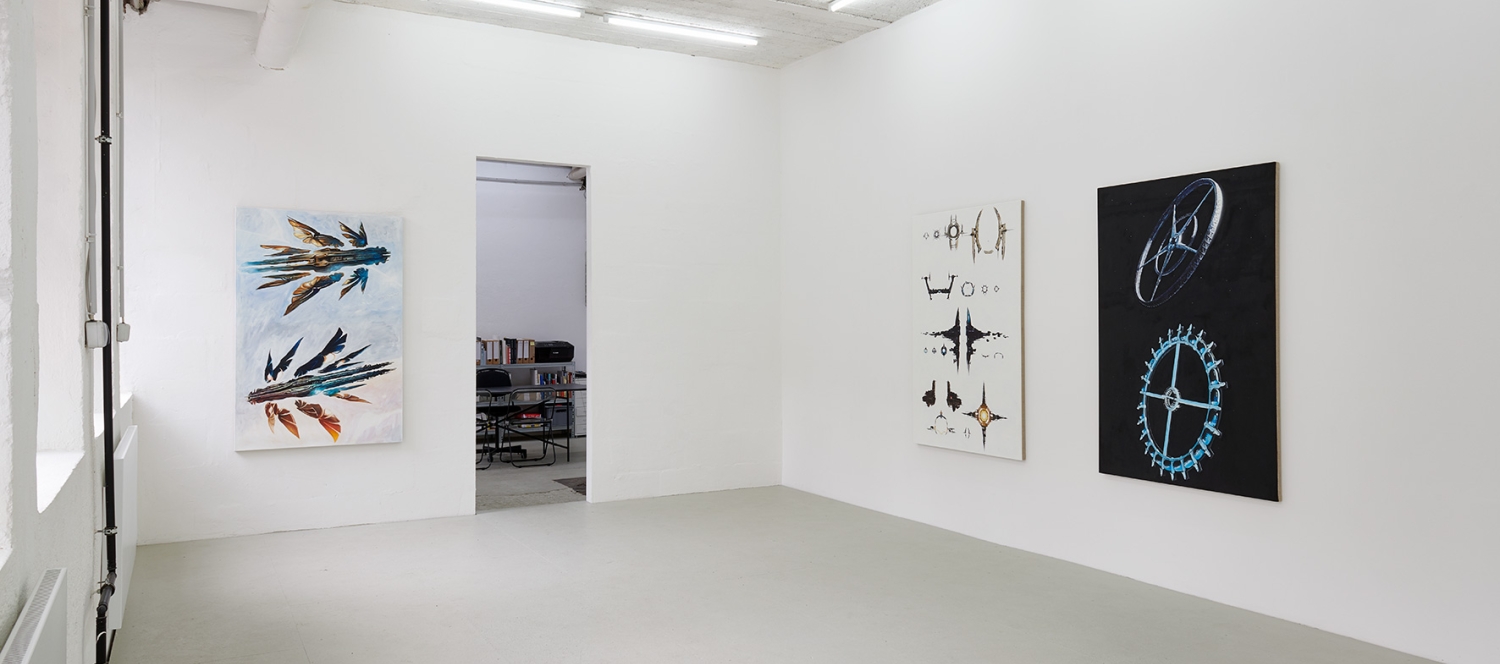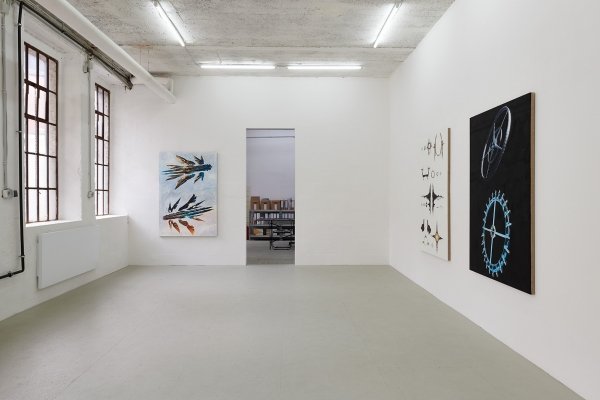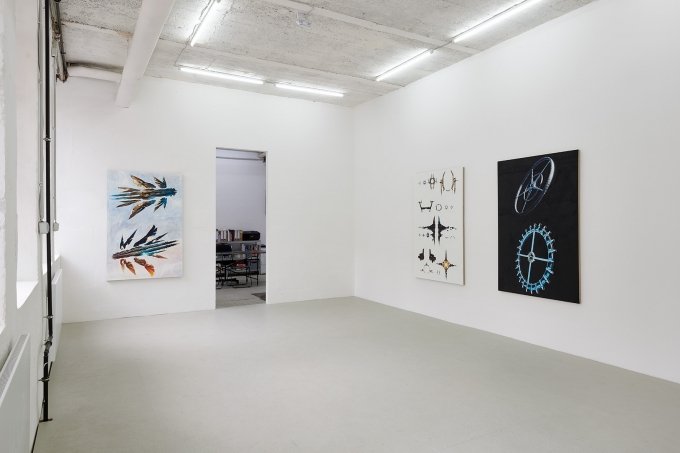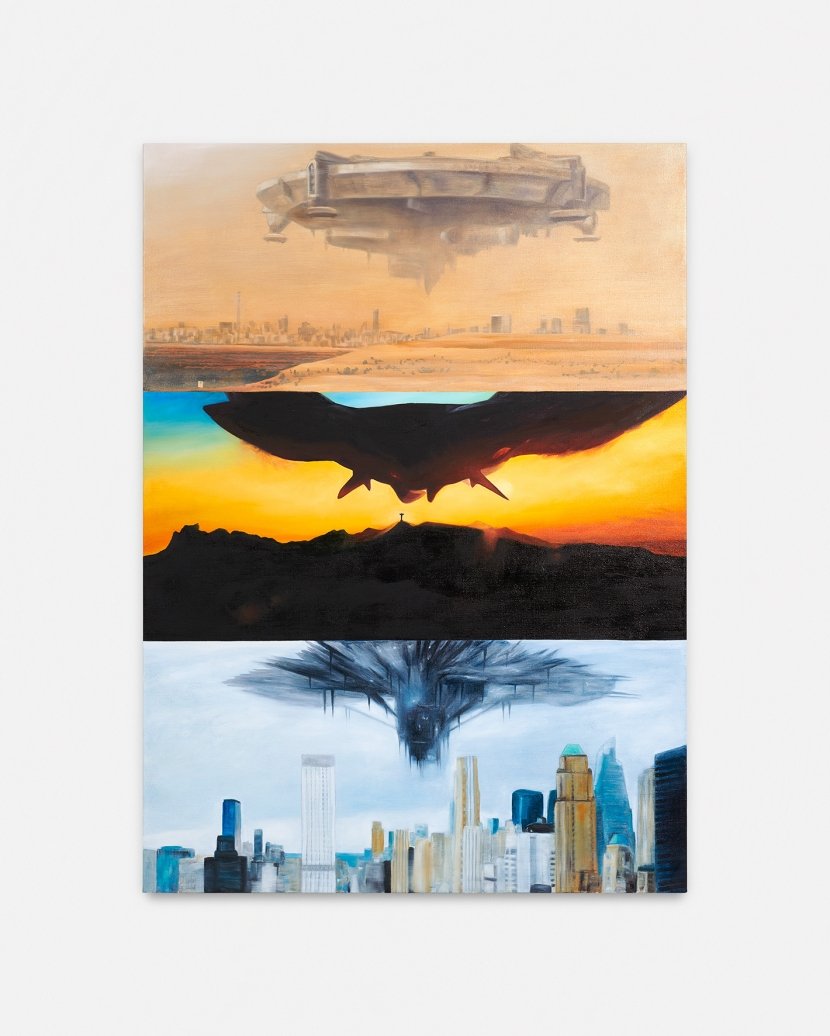Mathis Gasser bei Ginverva Gambino, Köln

Ginerva Gambino
Kyffhäuserstraße 31, 50674 Köln
Deutschland
KünstlerIn: Mathis Gasser
Titel: Structures and Institutions 2
Datum: 7. September – 26. Oktober 2019
Fotografie: All images copyright and courtesy of the artist and Ginerva Gambino, Cologne
Ausstellungstext:
Seen From Afar
The sky has always served as humanity’s site for prophecy and projection. From astrology to augury, it is a vast exhibition space, a crystal sphere for the foretelling of history. Up there, earthly experience takes shape in mythic constellations, prodigious comets and apocalyptic UFOs.Observing distant sites and structures is an act of creative interpretation and a mirror for the vagaries of life on earth. Fortunes continue to be told up there today---perhaps more so than ever--- as science and its fictions deliver us toward “the final frontier” of outer space. As technology brings humans closer towards the stars, cosmic vehicles will engender further questions about our own past trajectories.
Mathis Gasser’s new works deliver these chimeric combination of worlds and skies. Here, in painting, terrestrial imagery loses gravity and scale. Iridescent spacecraft float like tiny sea creatures through the cosmic depths and buzz over urban skylines on insectile wings. Earthly structures tumble through pictorial space, telescoping freely between near and far, monumental and microscopic, past and future, utopia and dystopia. Entitled Structures and Institutions 2, the series expands on a group of works produced in 2018, blending contemporary architectural projections with science-fiction concept art and fanbase images from the internet. The current series continues to explore the vehicles and structures that might govern, preserve or even potentially destroy planetary life, testing the visual and cultural relationships between them.
These assemblages mix and juxtapose elements from reality and fiction. For example, in Gasser’s universe, institutional architectures such as the United Nations and famed art museums stand beside sci-fi motherships, revealing new formal and conceptual resonances. Gasser’s paper collages distort familiar pictures of cities by toying with perspective and scale, shifting from aerial to interior views, merging skylines and clipper boats with extraterrestrial spacecrafts. This practice of montage has a distancing effect (Verfremdungseffekt) which plays with the viewer’s frames of reference, transforming everyday urban zones into alien civilizations.(1) Science fiction also parallels this power of montage. Its alternative ways of being allow us to gaze upon our own governing bodies and institutions with critical distance.
In this series, Gasser alienates institutional architecture through the forms of traveling spaceships. In science fiction, the alien mothership serves as the literal vehicle of an entire civilization, much like the buildings which convey our own technological, political, economic and cultural might. On the one hand, the megastructure’s monumental exterior imparts an aura of mystery that fuels the imagination. Concept art for space travel and science fiction illustrates interstellar vehicles and buildings whose interiors exist solely in the mind’s eye. As such, the geometric, self-contained world of an interstellar ship can possess a wondrous utopian quality: they are not only the future bearers of people and cargo, but also the vessels for potentially new and better forms of political and social organization. For archeologist Jerry Moore, such monumental edifices “are structures designed to be recognized, expressed by their scale or elaboration, even though their meanings might not be understood by all members of society.”(2) They are meant to be seen from outside and at a distance, dwarfing the beholder, who cannot see the complex and often chaotic operations occurring within.Thus, while the spaceship’s unitary structure might bear the marks of a progressive society, its contents, as well as the motives of its occupants, remain more uncertain. In science fiction narratives, the moment of alien arrival is tensely indeterminate: the alien vessel hanging in the skies over awestruck Earthlings momentarily suspends the fate of humanity between salvation and destruction. Gasser’s painting Objects in the Sky captures this very uncertainty, as three different alien vessels hover above a city skyline.(3) The ships reference three recent movies with an alien invasion plot: District 9 (2009, top), Childhood’s End (2015, middle), and The 5th Wave (2016, bottom). For Gasser, the on-screen re-emergence of these alien megastructures coincided with very real Earthly catastrophes, including the 2009 global financial recession, ongoing refugee crises, and climate change. For example, District 9 inverts the traditional alien invasion into a parable of post-Apartheid South African society, turning extraterrestrial immigrants into hostages of Earth. In The 5th Wave, alien technology provokes natural disasters and epidemics, and Childhood's End presents alien visitors as seemingly benevolent overlords with the power to erase war, poverty and disease. Gasser’s alien megastructures provide a form for the volatile forces that govern human life, such as the increasingly violent fluctuations of the global economy and environment. These structures can serve as harbingers of catastrophic change, but can also act as doubles for the globalized institutions which attempt to navigate them.
Even in its most utopian renderings, our starships must always navigate the crooked path of human history. The ghostly image of a clipper ship haunts Gasser’s collage views of modernbuildings and space stations, inserting the specter of humanity’s colonial crimes perpetrated within the previous maritime frontier. While the sea faring ship can symbolize human discovery, collaboration and technical ingenuity, it also recalls the violent conquer and destruction of other civilizations, carried out by ship. However, times and motivations have changed for these next pioneers. As the planet’s resources run thin and the environment changes, a fearful urgency drives our current dream of space colonization. The anthropologist Gökçe Günel states that “the spaceship insists on addressing the planetary-scale questions of survival in the unknown, the sustenance of the species beyond ecological catastrophe, and the preservation of an existing civilization, albeit in highly limited and confined form.”(4) Gasser addresses such concerns in his painting Elysium / Von Braun Space Station, which pairs two similar circular ships. The upper half features the space station from Neill Blomkamp’s 2013 film Elysium, which was designed after the one pictured beneath it, a hypothetical rotating space station first proposed by the aerospace engineer Wernher von Braun (1912-1977). In Elysium, the megastructure serves as a haven for Earth’s elite, now living far beyond the atmosphere of a destroyed and impoverished home planet. Yet the limits of utopian ideology become clear in the all-too-human history of its own model, which was designed by a scientist who, prior to his career in American aerospace, created ballistic missiles for the Nazi regime.
Although Gasser’s series presents architectural designs supposedly conceived and occupied by a myriad of collaborating agents, these real and imaginary spaces remain conspicuously empty. The very absence of inhabitants begs the question of who these supposedly progressive, utopian structures are intended to bear--- or, perhaps, who they might someday exclude, or even eradicate. His vessels and megastructures remind us that science fiction can be a critical tool. Indeed, the philosopher Henri Lefebrve has juxtaposed “abstract utopias,” in which the ideal loses contact with reality, with that of “the experimental utopia,” which constitutes an “exploration of human possibilities, with the help of the image and the imagination...a ceaseless reference to the given problematic in the ‚real’.”(5) To this day, starships can provide our current society and its institutions with this experimental mode of thought. For literary critic Frederic Jameson, the starship narrative’s trajectory can never truly be untethered from our world: “So it is that en route to space and to galactic escapism, we find ourselves locked in the force field of very earthly political realities.”(6)
1. Georges-Didi Huberman, The Eye of History : When Images Take Positions, trans. Shane B. Lillis (Toronto: RICBOOKS/MIT press, 2019).
2. Jerry D. Moore, Architecture and Power in the Ancient Andes : The Archaeology of Public Buildings (Cambridge: Cambridge University Press, 2005).
3. See the artist’s text: Mathis Gasser, “Objects in the Sky,” Brave -New-Life, January 31 2019: https://brand-new-life.org/b-n-l/objects-in-the-sky/
4. Gökçe Günel, Spaceship in the Desert: Energy, Climate Change, and Urban Design in Abu Dhabi (Durham: DukeUniversity Press, 2019), 42.
5. Quoted in Tod McDonough, “Metastructure: Experimental Utopia and Traumatic Memory in Constant's New Babylon,”Grey Room, No. 33 (Fall 2008): 85, 88. 6 Frederic Jameson, Archaeologies of the Future: The Desire Called Utopia and Other Science Fictions. (New York:Verso, 2005), 266.
Samuel Luterbacher is a PhD candidate in Art History at Yale University and current Andrew W.Mellon Predoctoral Fellow at The Center for Advanced Study in Washington D.C. His research focuses on intercultural contact and the movement of portable artifacts in the Early Modern Iberian empires at the dawn of globalization.
Mathis Gasser (*1984, Zurich) lives and works in London. His work has been shown at the following institutions and spaces: Weiss Falk, Basel (2018); Cell Project Space, London(2018); Kunsthaus Glarus, Glarus (2017); Museum of Contemporary Art, Belgrade (2017);Chewday's, London (2017); Centre d‘edition contemporaine, Geneva (2016); Musée d’art etd’histoire, Geneva (2016); Kraupa-Tuskany Zeidler, Berlin (2016); Swiss Institute, New York(2016); et al.





